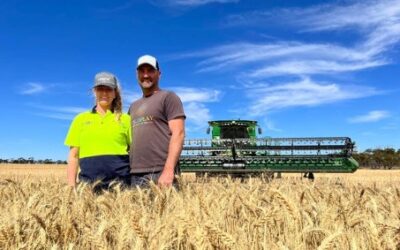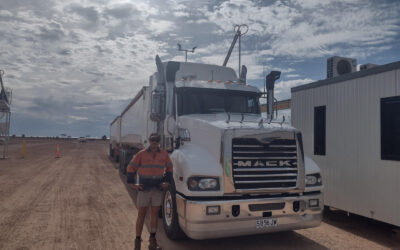An official sod turning event today at the T-Ports Lucky Bay bunker site has marked the start of a new era in grain handling and exports on the Eyre Peninsula.
T-Ports CEO Kieran Carvill said while the ceremony signalled the official start of the project, planning had been underway for several years with growers, investors and the EP community to receive equal benefit from the project.
“We have been meeting with growers on the EP over the past week and the enthusiasm and excitement for a real, tangible alternative grain supply chain in which they have equity is obvious,” he said.
“We know growers have been promised many things over many years but turning the sod today and having earthmoving equipment already at the site demonstrates this project is here to stay and we see a long and beneficial partnership with EP communities.
“We believe it will create a new way of business for EP growers where, rather than the harvest rush to get grain into the bulk handling system, they may consider investment in on-farm storage to return benefits in cheaper delivery direct to port in the post-harvest period.”
Member for Flinders Peter Treloar, Managing Director of investment partner ICAM Freddy Bartlett and Mr Carvill turned the first official sod. They were joined by Member for Giles Eddie Hughes and representatives from Franklin Harbour District Council, Elliston District Council, the Eyre Peninsula Regional Development Board and growers who have committed tonnage to the project.
The $115 million project features the Lucky Bay port facility, a state-of-the-art shallow draft transhipment vessel with a 3500-tonne capacity, grain storage facilities at the port with the capacity to hold 27,000 tonnes, bunkers at Lucky Bay with 360,000 tonnes of storage and up-country storage at Lock with the capacity to hold 150,000 tonnes.
The construction at the bunker sites at both Lock and Lucky Bay has begun in recent weeks, with mobilisation of construction at the port scheduled for mid-July.
“This investment innovates upon the traditional port model and almost monopolistic grain supply chain in South Australia through proven transhipping technology that has been utilised in other industries for the past 20 years,” Mr Carvill said.
“The lower build cost and lower environmental footprint compared with traditional export port facilities in SA has made the financial feasibility of the investment easier to attain with a lower throughput requirement from growers.
“This model means growers can access multiple small ports that can load vessels up to and including panamax, allowing product to be exported profitably, which will prove a great benefit to EP growers and South Australia.”
Local contractors have been employed for the build, including Ahrens, Lucas Total Contract Solutions and Buttrose Earthmovers.



